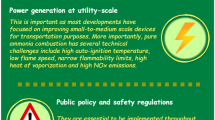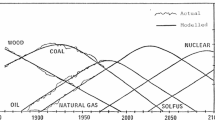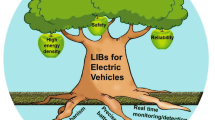Abstract
Within the aluminum electrolysis industry it is well known and well documented that there exists a relationship between bath temperature and excess AlF3. This relationship is often referred to as the correlation line. Inspired by this awareness, this paper proves the correlation line theoretically. This is done in two steps. First, the correlation line is derived from a model of mass and energy balance of an electrolysis cell. Second, the theoretically derived correlation line is verified experimentally.
Similar content being viewed by others
References
P. Desclaux, “AlF3 Additions Based on Bath Temperature Measurements,” Light Metals 1987, ed. R.D. Zabreznik (Warrendale, PA: TMS, 1987), pp. 309–313.
D.J. Salt, “Bath Chemistry Control System,” Light Metals 1990, ed. C.M. Bickert (Warrendale, PA: TMS, 1990), pp. 299–304.
K. Grjotheim and H. Kvande, Introduction to Aluminium Electrolysis, second edition (Dusseldorf: Aluminium-Verlag, 1993).
A. Solheim (personal communication, June 2005).
M.M. Hyland et al., “Aluminium Fluoride Consumption and Control in Smelting Cells,” Scandinavian Journal of Metallurgy, 30 (2001), pp. 404–414.
J. Thonstad and S. Rolseth, “Equilibrium between Bath and Side Ledge,” Light Metals 1983, ed. E.M. Adkins (Warrendale, PA: TMS, 1983), pp. 415–424.
A. Meghlaoui, Y.A. Al Farsi, and N.H. Aljabri, “Analytical and Experimental Study of Fluoride Evolution,” Light Metals 2002, ed. Wolfgang Schneider (Warrendale, PA: TMS, 2002), pp. 283–287.
P.M. Entner and G.A. Gudmundsson, “Further Development of the Temperature Model,” Light Metals 1996, ed. Wayne Hale (Warrendale, PA: TMS, 1996), pp. 445–449.
P.M. Entner, “Control of Bath Temperature,” Light Metals 1995, ed. James W. Evans (Warrendale, PA: TMS, 1995), pp. 369–374.
P.M. Entner, “Control of AlF3 Concentration,” Light Metals 1992, ed. Euel Cutshall (Warrendale, PA: TMS, 1992), pp. 369–374.
P.M. Entner, “Further Development of the AlF3-Model,” Light Metals 1993, ed. Subodh K. Das (Warrendale, PA: TMS, 1993), pp. 265–268.
T. Drengstig, D. Ljungquist, and B. Foss, “On AlF3 and Temperature Control of Aluminium Electrolysis Cell,” IEEE Trans. on Control Systems Technology, 6(2) (1998), pp. 157–171.
M.J. Wilson, “Practical Considerations Used in the Development of a Method for Calculating Aluminium Fluoride Based on Cell Temperature,” Light Metals 1992, ed. Euel Cutshall (Warrendale, PA: TMS, 1992), pp. 375–378.
W. Haupin and H. Kvande, “Mathematical Model of Fluoride Evolution from Hall-Héroult Cells,” Light Metals 1993, ed. Subodh K. Das (Warrendale, PA: TMS, 1993), pp. 257–263.
M.P. Taylor, “Fluoride Material Balance,” Proceedings of the Fourth Australian Aluminium Smelter Technology Workshop (Sidney Australia, 25–30 October 1992), pp. 720–732.
J.M. Peyneau, “The Automated Control of Bath Composition on High Amperage Cell,” Proceedings of International Symposium on Reduction and Casting of Aluminium 1988 (Montreal Canada, 28–31 August 1988), pp. 189–195.
T. Drengstig, “On Process Model Representation and AlF3 Dynamics of Aluminium Electrolysis Cells” (Dr.Ing. thesis, Norwegian University of Science and Technology (NTNU), 1997).
T. Drengstig, S. Kolås, and T. Støre, “The Impact of Varying Conductivity on the Control of Aluminum Electrolysis Cells,” Light Metals 2002, ed. Wolfgang Schneider (Warrendale, PA: TMS, 2002), pp. 377–382.
J.J.J. Chen and M.P. Taylor, “Control of Temperature and Aluminium Fluoride in Aluminium Reduction,” Aluminium, 7/8 (2005), pp. 678–682.
S. Kolås and T. Støre, “Bath Temperature and AlF3 Control of an Aluminium Electrolysis Cell,” submitted to Control Engineering Practice (2006).
A. Solheim and L. Støen (personal communication, 2005).
Author information
Authors and Affiliations
Rights and permissions
About this article
Cite this article
Kolås, S. Defining and verifying the “correlation line” in aluminum electrolysis. JOM 59, 55–60 (2007). https://doi.org/10.1007/s11837-007-0066-8
Published:
Issue Date:
DOI: https://doi.org/10.1007/s11837-007-0066-8




